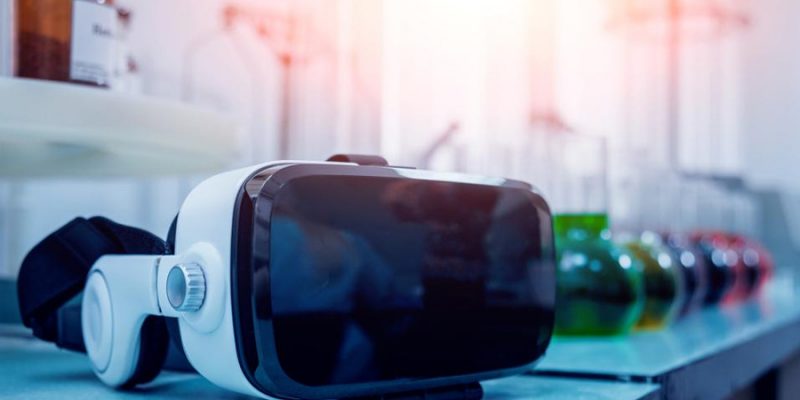
Virtual reality has a wide variety of applications in healthcare like robotic surgery, phobia therapy, surgical skill training, and many more.
Virtual reality (VR) has taken the globe by storm over the last several years, and the trend is only growing in popularity. Rapidly emerging technology are altering our perceptions of the world and the way different sectors work. Although virtual reality has changed the gaming business, it is no longer limited to that industry. Different sectors are creating fresh ways and procedures to better their processes by using the newest technology. There have been several dialogues and discussions concerning the use of virtual reality in the healthcare business, with various virtual reality apps currently in use.
Pain Management
Virtual reality (VR) is fast changing the healthcare industry, influencing how patients and professionals receive and give treatment. VR offers standard distraction methods a new face by providing a range of engaging diversions. These interactive games are played in a virtual environment. While some applications provide therapeutic virtual reality for burn victims, there are other much-improved approaches for efficient limb pain management. Furthermore, as a drug-free pain management alternative, VR may be used in conjunction with or without clinical care settings.
Mental Illness Treatment
Exposure therapy is a popular treatment strategy for a variety of mental illnesses. Virtual reality is increasingly changing the way exposure therapy is offered to mentally ill patients by providing a low-cost, flexible, and low-risk treatment alternative. VR also helps in the treatment of anxiety and panic attacks by providing new ways for keeping the body calm and serene.
Medical Education
Virtual reality simulation technologies have long been used in medical education and training. Major virtual reality (VR) companies are developing solutions that combine 360-degree video with 3D interactive data to give the best learning programmes for physicians and students. This technology allows them to execute complex, life-saving surgeries in a risk-free environment, while also developing their talents and receiving usability feedback. Virtual reality is making inroads into the nursing field.
Surgical Training
By doing various sorts of simulated treatments in the virtual domain, virtual reality allows surgeons to overcome practical skill shortcomings more rapidly. Surgeons can become skilled specialists without using expensive one-time-use mannequins. The most common application of virtual medical reality is surgery. It’s impossible to imagine a medical profession in which imaging and practical alternatives to physicians’ acts are more important. No dummy can compete with virtual reality smartphone apps in terms of plausibility
Improve Dentistry
Virtual reality may also aid both new and experienced dentists in honing their abilities and adjusting to new dental technology. They may explore 3D models and textures of teeth, jaws, and mouths using virtual reality technology. MOOG’s haptic technology is an excellent example of a virtual surgeon simulator. This virtual environment offers the most exact simulation of dental procedures as well as a variety of ailments, concerns, and treatment options.
Alleviating Phobias
Virtual reality phobia treatment is now available, providing patients with a high-tech, cutting-edge option for conquering their concerns and enjoying a better life. VRET may be a viable therapeutic option for those who are afraid of driving, panic, heights, spiders, water, fire, or anything else. This is only one of numerous virtual reality (VR) therapies that are being developed or utilised to address mental health issues.
Personal Fitness
Virtual reality is helping healthcare in a variety of ways by directly contacting patients. VR fitness applications may make your training more entertaining by gamifying it or transporting you to virtual surroundings. There is already a plethora of these programmes accessible. These programmes can help people improve their overall health and avoid future health issues. Virtual reality fitness apps may teach you activities and provide feedback on your motions, turn exercise into a game, or motivate you to exercise even when the weather is terrible by offering picturesque backgrounds for treadmill jogging or stationary bike riding.
Diagnostics
Doctors and clinicians are using virtual reality (VR) as a powerful diagnostic tool to help them make an accurate diagnosis. This is done in combination with other treatments, such as MRI/CT scans, and eliminates the need for any invasive techniques, giving the patient a pain-free experience. VR allows for the detection of modest abnormalities in the early stages of Alzheimer’s disease. Alzheimer’s disease can be discovered early by utilising a virtual reality maze test, in which persons aged 18 to 30 are asked to navigate a virtual maze in order to assess the activity of certain brain cells.
Alcoholism Treatment
Because behavioural treatment requires patients to feel their anxiety in a controlled manner in order to make them re-evaluate their choices, alcoholism has been a severe challenge for psychotherapists. The problem is figuring out how to make the therapy cost-effective, quick, and easy. The best method is to deal with the initiating aspects right away – i.e., virtual reality. The patient and psychotherapist can collaborate in a virtual scenario where the patient’s behaviour can be observed via a VR programme. Doctors can also use visual representations of the adverse consequences of alcoholic beverages to wean individuals off their addiction.
Cancer Screening
Every year, more than two million endoscopies are performed as part of cancer screening. Because this surgery is invasive and costly, it is out of reach for the vast majority of patients. As a result, virtual endoscopy is changing the tides by matching traditional endoscopic performance without adding to the current complexity. It creates 3D volumetric models of organs that help surgeons pick the best course of action, notably in the case of brain tumours, which can be traumatic for even the most skilled surgeons to remove.



















